Explore the River Oise in the Footsteps of the Impressionists
- SUBSCRIBE
- ALREADY SUBSCRIBED?
BECOME A BONJOUR PARIS MEMBER
Gain full access to our collection of over 5,000 articles and bring the City of Light into your life. Just 60 USD per year.
Find out why you should become a member here.
Sign in
Fill in your credentials below.
It was the coming of the railway that made the sleepy agricultural villages and towns along the River Oise so attractive to the Impressionists. They were dedicated to painting in the open air and mostly short of cash because their new style of painting did not sell. The region offered varied landscapes which were just beginning to be affected by industrialization but had not yet become suburban and it was within easy reach of Paris, with lower rents.
What was true for the Impressionists is still true for today’s Parisians looking for a rewarding day out in the country. The creation of the new town of Cergy Pontoise in the 1960s led to the building of a second railway line, the RER A, but development and population expansion have been mainly inland. The banks of the river have changed remarkably little in over 100 years. They are still lined with 19th century villas and often the only sound is that of birdsong as huge working barges slide silently past. Even in winter, in the rain, and with restaurants closed because of the current restrictions, you can be sure of spacious views, not many people, most of them local, and a railway station within easy reach.
Dr. Gachet, the doctor and friend of many Impressionist painters, moved to Auvers-sur-Oise in 1872. His friend Camille Pissarro settled in Pontoise in the same year. Known affectionately as “the father of Impressionism,” he invited his younger painter friends, Cézanne, Gauguin and Van Gogh among others, to paint with him there. The railway also turned obscure villages such as Eragny into popular destinations for weekend visitors from Paris, who came to fish along the banks of the Oise. The fondue restaurant O Châlet was once a guinguette from where a ferry took fishermen across the river, and something of the guinguette holiday atmosphere still lingers in its cozy interior, packed with local families at the weekend.
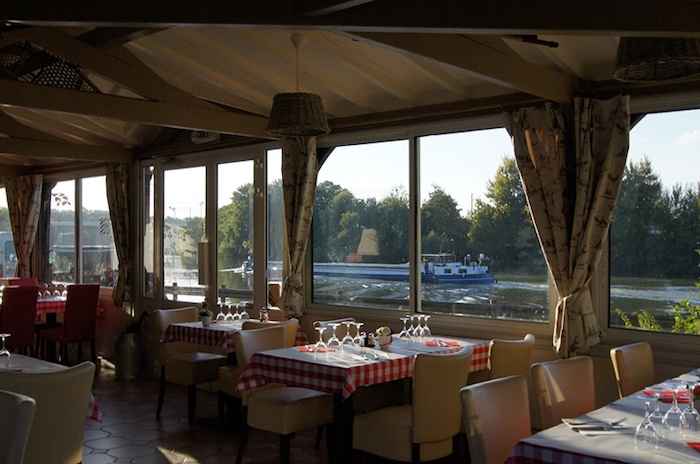
O Châlet, Eragny. Photo credit © O Châlet
The suggested 7½ km walk along the left bank of the Oise starts at Saint-Ouen-l’Aumône station with a detour to the 13th century Abbaye de Maubuisson, then follows the river past Pontoise and the views painted by Pissarro and his friends to the fondue restaurant at Eragny, ending at the SNCF station of Eragny Neuville, with an alternative walk to the RER station of Neuville Université. But you could skip the Abbey and Pontoise and start the walk at Saint-Ouen-l’Aumône Quartier de l’Eglise station instead, ending at either of the two stations at Eragny (4½ km) or just walk to the restaurant for lunch from either station and back (3 km). You could also prolong the walk along the Oise from the restaurant, crossing the bridge to Cergy Port for the RER stations at Cergy Préfecture (5 km) or Cergy St Christophe (7 km).
7½ km walk from St Ouen l’Aumône to Eragny Neuville
From the station take the exit marked “Rue du 8 mai 1945” and turn left, under the railway bridge. Take the pedestrian crossing into the Rue Guy Sourcis opposite on your right and follow the railway line until you reach a level crossing. Cross the line and turn left, following the sign for “Abbaye de Maubuisson” into Avenue Richard de la Tour.
Follow the path right round to the park entrance, from where you will see a long low building, the former chapter house which now functions as an arts center.
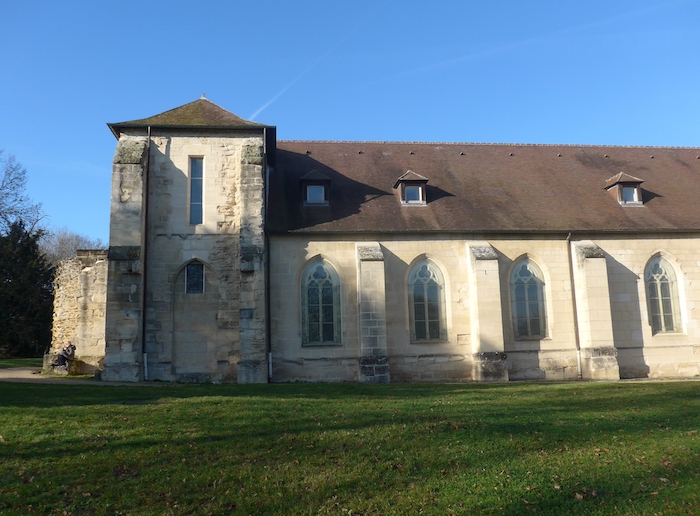
Abbaye de Maubuisson. Photo credit © Annabel Simms
This building is all that remains of the once extensive Abbey which covered 79 acres, but it is impressive enough to make the visit worthwhile, even though the current restrictions mean that you cannot go inside. With the little stream of the Liesse flowing through its grounds and even fewer visitors than usual, the Abbey is a good place for a picnic.
It was founded in 1236 by Blanche of Castille, the pious wife of Louis VIII and the mother of Louis IX, Saint Louis, close to her château in Pontoise. It was both a Cistercian convent for up to 120 young women of royal or noble birth and an occasional royal residence. It was from here that Philippe le Bel issued the infamous order to arrest the Knights Templar in 1307. But by the end of the 18th century it had fallen into decline, with only a few nuns left when it was closed on the order of Louis XVI in 1786.

Abbaye de Maubuisson at the beginning of the 17th century. Photo credit © Wikimedia Commons
Retrace your steps to the level crossing and continue downhill to the very end of the Chaussée de Maubuisson. Cross the main road and take the footpath opposite, marked “Chemin de Pothuis” which leads to the Oise.
Turn left along the towpath. Across the river you will soon see the gracious silhouette of the 12th century cathedral at Pontoise. Eventually you will pass some concrete bases with an information panel beside them explaining that they were part of the “Ligne Chauvineau,” a line of military anti-tank defenses put up along the Oise in 1939 to protect Paris from invasion.
A little further on you will pass reproductions of 11 paintings done between 1872 and 1908, nine of them by Pissarro in the 1870s, placed at the spot where they were painted.

Quai du Pothuis, Pontoise, Camille Pissarro 1876. Photo credit © Annabel Simms
Pissarro lived across the river in Pontoise at 85 Quai du Pothuis. The views have not changed as much as you might expect, although some of the factories shown in the paintings have disappeared. The sight of the bridge and the ramparts at Pontoise, in the Middle Ages a frontier town defending the borders of the kingdom of France, immediately explains the appeal of this spot to a painter.

Pontoise from the Quai du Halage, St Ouen l’Aumône. Photo credit © Annabel Simms
Continue along the towpath, past the lock and another bridge. About 250 meters after the bridge you will pass a former inn, Le Goujon d’Eragny, with a worn stone memorial tucked under a side window, facing the direction in which you are walking.

RAF memorial at the Goujon d’Eragny, Chemin de Halage, Eragny. Photo credit © Annabel Simms

RAF memorial at the Goujon d’Eragny, Chemin de Halage, Eragny. Photo credit © Annabel Simms
It was put up by the inhabitants of Eragny in memory of one of the seven crew of an RAF Lancaster bomber whose body was recovered here after the plane crashed on 6 June 1944. It was on a mission to destroy the station at Achères to hamper German communications during the D-Day landings but was brought down by anti-aircraft fire. It exploded over the 11th century church at Eragny, which was completely destroyed, although no civilians were killed. Six of the airmen are buried together in the new cemetery at Eragny; the body of the seventh was never recovered and must have fallen into the Oise.
Soon afterwards you will pass O Châlet, with a row of skis outside and the red and white flag of Haute Savoie, a reminder of the regional dishes of raclette and fondue in which the restaurant specializes.

O Châlet fondue restaurant, Eragny. Photo credit © Annabel Simms
I first passed it on a Sunday walk along the Oise last February and went inside to ask for their card. It was like stepping into a 1950s time-warp, packed with local multi-generational families in festive mood and pervaded by the delicious smell of melting cheese. Modest family-owned places like this are fast disappearing in the Ile de France and I made a mental note to go back and try it out. I did go back on a rainy Sunday several weeks later, with my family who were over on a visit from England. The six of us were the only foreigners but we immediately felt at home. The kir was made of rosé wine flavored with griotte cherries and it was generous and good. So was the fondue and the very reasonably-priced house wine. When the owners discovered that we had come all the way from Paris by train in non-stop rain they offered us a lift back to the station, which we gratefully accepted. I have not been able to return because lockdown intervened but they assure me that they will be re-opening as soon as it ends. My 24-year-old niece later told me that the trip to “the restaurant by the river” was the highlight of her Paris visit.
O Châlet is on the corner of Rue de la Fontaine, which leads to La Carrière à Pépin, a former quarry a few meters away. The information panel there reproduces a photo of Débussy and his wife posing in front of the quarry on a visit to Eragny in 1902.
To reach the SNCF station at Eragny Neuville follow the Rue de la Fontaine uphill, past the quarry. The street is named for a local spring which never freezes in winter, making it a valued resource in the days before piped water was supplied to every house. A lavoir (wash house) was built around it in the 19th century, and until the 1950s professional washerwomen came from other villages to do the washing for Paris weekend visitors to Eragny. It is located just after the bend in the road, down steps on the left, with an information panel showing a rare photo of a lavoir in use.
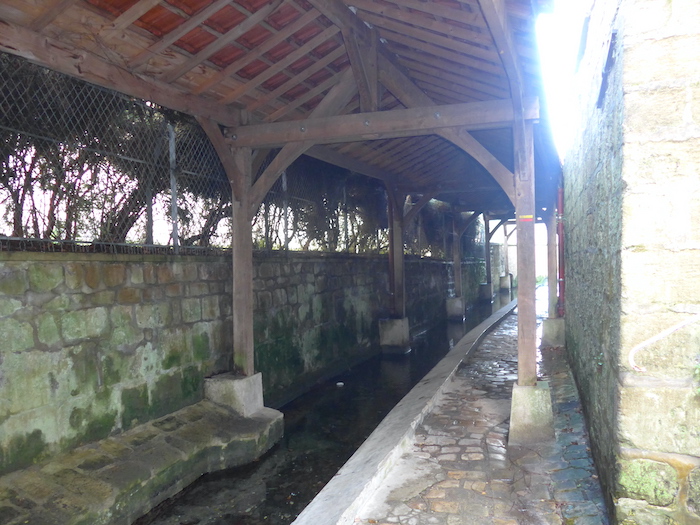
Lavoir, Rue de la Fontaine, Eragny. Photo credit © Annabel Simms
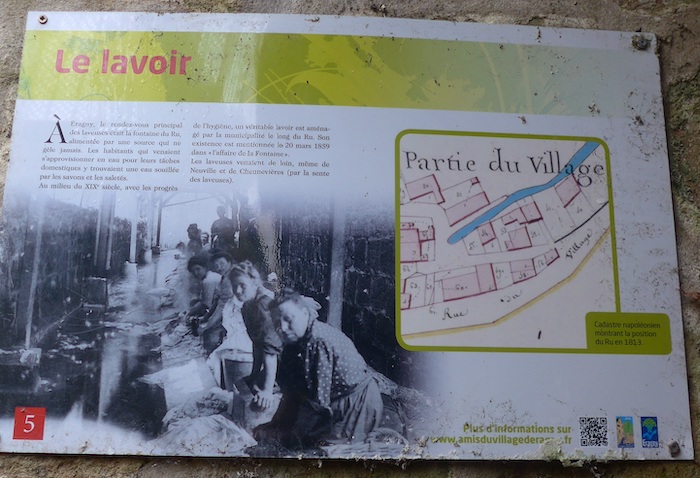
Lavoir, Rue de la Fontaine, Eragny. Photo credit © Annabel Simms
Continue to the end of Rue de la Fontaine and turn sharp right uphill into Rue de la Gare. At the little roundabout take the first right into Rue de Neuville. There is a good view of the Oise from here just before you turn left into the little Rue des Belles Hâtes, which leads to steps down to the station. Cross to the other side for trains to Paris.
NB: If you are heading for the RER station at Neuville Université, continue from O Châlet to the next bridge. Take the road under the bridge, the Chemin de la Carrière à Pépin, follow it uphill and round to the left and go up steps on your right onto a main road. Cross at the pedestrian crossing on your left and turn left past the Parc Relais car park, then take the first right which will lead you through the bus station to the RER station.

Walk from St Ouen l’Aumône to Eragny-Neuville, IGN Carte TOP 25, 2313 OT, scale 1 cm to 250m. Photo credit © Annabel Simms
Trains from Gare du Nord to Pontoise run twice an hour, stopping at Saint-Ouen-l’Aumône 38 minutes later. Trains from Eragny-Neuville to Saint-Lazare run two to three times an hour, taking 35 minutes.
RER A trains from Neuville Université to Châtelet-Les Halles run three times an hour, taking 34 minutes. Head to the Translien website for more information.
Free app using GPS to track your route on IGN maps
Annabel Simms is the author of An Hour From Paris (3rd edition 2019) and Half An Hour From Paris (2018), both available on Amazon.
Lead photo credit : The Oise opposite O Châlet, Eragny. Photo credit ©Annabel Simms
More in hiking near Paris, Paris Walks
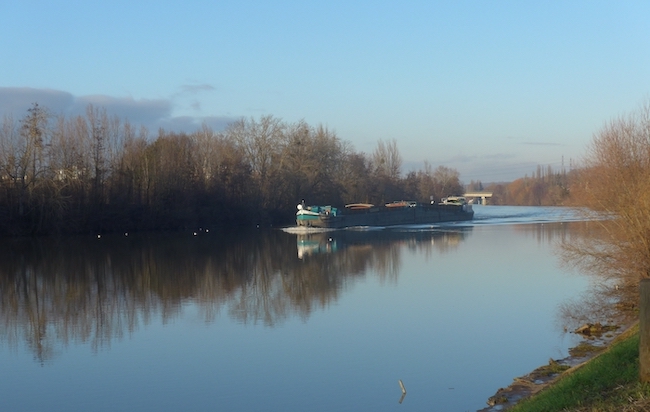
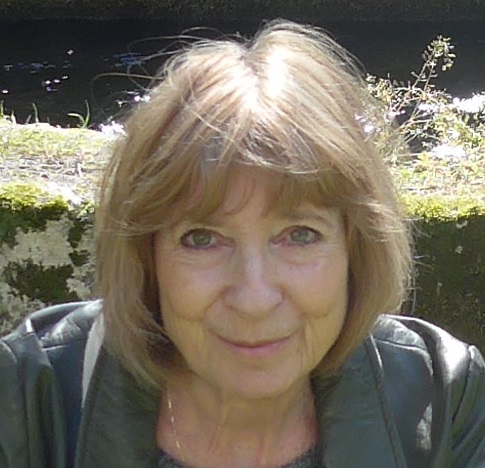




REPLY
REPLY